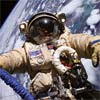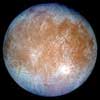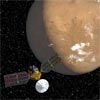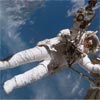|
News Archive: Feb. 1-28 |

|
Sensor being developed to check for life on Mars
NASA-funded researchers are refining a tool that could not only check for the faintest traces of life's molecular building blocks on Mars, but could also determine whether they have been produced by anything alive.
 FULL STORY FULL STORY
 |  |

|
 |
Larger and larger lakes being discovered on Titan
Cassini's radar instrument during a near-polar flyby of Saturn's moon Titan last week found a big island smack in the middle of one of the larger lakes imaged so far. The image offers further evidence that the largest lakes are at the highest latitudes.
 FULL STORY FULL STORY
 |  |

|
 |
Hail storm damage grounds space shuttle Atlantis
A sudden, explosive thunderstorm Monday battered the shuttle Atlantis' external fuel tank with wind-driven, golf ball-sized hail, causing extensive damage to the tank's protective foam insulation. NASA managers said Tuesday engineers will have to move the shuttle back to the Vehicle Assembly Building for repairs, delaying launch on a space station assembly mission from March 15 to late April.
 FULL STORY FULL STORY
 EARLIER STORY EARLIER STORY
 PAST SHUTTLE ROLLBACKS PAST SHUTTLE ROLLBACKS
 IMAGES: PHOTOS OF HAIL DAMAGE IMAGES: PHOTOS OF HAIL DAMAGE
 VIDEO: STS-117 COVERAGE VIDEO: STS-117 COVERAGE
 |  |

|
 |

Additional coverage for subscribers:
 VIDEO:
NASA BRIEFING ON LAUNCH DELAY AND ROLLBACK PLANS PLAY VIDEO:
NASA BRIEFING ON LAUNCH DELAY AND ROLLBACK PLANS PLAY
 SUBSCRIBE NOW SUBSCRIBE NOW

|
King of the planets will propel probe to Pluto
A NASA probe tasked with exploring the furthest reaches of the solar system will receive a boost in speed from Jupiter early Wednesday as it flies more than one million miles from the giant planet.
 FULL STORY FULL STORY
 LAUNCH COVERAGE LAUNCH COVERAGE
 |  |

|
 |

Additional coverage for subscribers:
 VIDEO:
SCIENCE PREVIEW OF JUPITER FLYBY PLAY VIDEO:
SCIENCE PREVIEW OF JUPITER FLYBY PLAY
 MORE: NEW HORIZONS LAUNCH COVERAGE MORE: NEW HORIZONS LAUNCH COVERAGE
 SUBSCRIBE NOW SUBSCRIBE NOW

|
Looking for life on Jupiter's icy moon Europa
While NASA and the European Space Agency focus on Mars rovers and future missions to search for life on the Red Planet, a determined core of scientists is lobbying for equal attention to a place they feel is just as likely to harbor life - Jupiter's icy moon Europa.
 FULL STORY FULL STORY
 |  |

|
 |
Soyuz base construction opens in French Guiana
The construction site of the Soyuz launch base in French Guiana was officially opened Monday by leaders from the European, French and Russian space agencies and Arianespace.
 FULL STORY FULL STORY
 |  |

|
 |
Detection of a colliding-wind beyond the Milky Way
Imagine two stars with winds so powerful that they eject an Earth's worth of material roughly once every month. Next, imagine those two winds colliding head-on. Such titanic collisions produce multimillion-degree gas, which radiates brilliantly in X-rays. Astronomers have conclusively identified the X-rays from about two-dozen of these systems in our Milky Way. But they have never seen one outside our galaxy - until now.
 FULL STORY FULL STORY
 |  |

|
 |
Comet-bound probe enjoys close encounter with Mars
Europe's Rosetta comet probe shot past Mars early Sunday to line up for another swing by Earth later this year, putting the craft on course to reach its icy target in 2014. Rosetta zoomed just 150 miles above the Martian surface at about 22,500 miles per hour relative to the Red Planet.
 FULL STORY FULL STORY
 |  |

|
 |
Study uncovers leaks in Antarctic 'plumbing system'
Scientists using NASA satellites have discovered an extensive network of waterways beneath a fast-moving Antarctic ice stream that provide clues as to how "leaks" in the system impact sea level and the world's largest ice sheet. Antarctica holds about 90 percent of the world's ice and 70 percent of the world's reservoir of fresh water.
 FULL STORY FULL STORY
 |  |

|
 |
Japanese rocket puts spy spacecraft into orbit
A radar spy satellite impervious to darkness and a second-generation craft with optical cameras were successfully launched into space Saturday to begin top secret reconnaissance missions for the Japanese government.
 FULL STORY FULL STORY
 |  |

|
 |
Celebrating supernova's 20th anniversary
Twenty years ago, astronomers witnessed one of the brightest stellar explosions in more than 400 years. The titanic supernova, called SN 1987A, blazed with the power of 100 million suns for several months following its discovery on Feb. 23, 1987.
 FULL STORY FULL STORY
 |  |

|
 |
XMM-Newton reveals a magnetic surprise
ESA's X-ray observatory XMM-Newton has revealed evidence for a magnetic field in space where astronomers never expected to find one. The magnetic field surrounds a young star called AB Aurigae and provides a possible solution to a twenty-year-old puzzle.
 FULL STORY FULL STORY
 |  |

|
 |
Station crew goes outside to free stuck antenna
Space station commander Michael Lopez-Alegria and Russian flight engineer Mikhail Tyurin completed a six-hour, 18-minute spacewalk Thursday to free a navigation antenna on a Progress supply ship. The antenna was jammed against the Zvezda command module.
 POST-EVA STATUS REPORT POST-EVA STATUS REPORT
 ANTENNA FREED ANTENNA FREED
 EVA BEGINS EVA BEGINS
 |  |

|
 |
Spitzer gets first sniffs of air from alien worlds
NASA's Spitzer Space Telescope has captured for the first time enough light from planets outside our solar system, known as exoplanets, to identify signatures of molecules in their atmospheres. The landmark achievement is a significant step toward being able to detect life on rocky exoplanets and comes years before astronomers had anticipated.
 FULL STORY FULL STORY
 |  |

|
 |
Ulysses sees surprises from the Sun's south pole
Although very close to the minimum of its 11-year sunspot cycle, the Sun showed that it is still capable of producing a series of remarkably energetic outbursts, the joint ESA/NASA Ulysses mission revealed.
 FULL STORY FULL STORY
 |  |

|
 |
Best bet for finding Mars life
Hunting for traces of life on Mars calls for two radically different strategies, says Arizona State University professor Jack Farmer. Of the two, he says, with today's exploration technology we can most easily look for evidence for past life, preserved as fossil "biosignatures" in old rocks.
 FULL STORY FULL STORY
 |  |

|
 |
Integral points to fastest spinning neutron star
Astronomers using the European Space Agency's gamma-ray observatory, Integral, have detected what appears to be the fastest spinning neutron star yet. This tiny stellar corpse is spinning 1122 times every second. If confirmed, the discovery gives the chance to glimpse the insides of the dead star.
 FULL STORY FULL STORY
 |  |

|
 |
Five spacecraft launched to probe space storms
Aiming to uncover the physics that power the auroras that crown Earth's poles, five tiny probes have been launched into space for a synchronized orbital dance to locate where the trigger is pulled to create the eerily magnificent displays.
 FULL STORY FULL STORY
 MISSION STATUS CENTER MISSION STATUS CENTER
 IMAGES: AERIAL VIEWS OF ROCKET IMAGES: AERIAL VIEWS OF ROCKET
 IMAGES: FRIDAY'S GANTRY ROLLBACK IMAGES: FRIDAY'S GANTRY ROLLBACK
 IMAGES: SATURDAY'S GANTRY ROLLBACK IMAGES: SATURDAY'S GANTRY ROLLBACK
 IMAGES: LAUNCH PHOTO GALLERY IMAGES: LAUNCH PHOTO GALLERY
 IMAGES: MORE LAUNCH PHOTOS IMAGES: MORE LAUNCH PHOTOS
 THEMIS OVERVIEW THEMIS OVERVIEW
 LAUNCH TIMELINE LAUNCH TIMELINE
 GROUND TRACK MAP GROUND TRACK MAP
 |  |

|
 |

Additional coverage for subscribers:
 VIDEO:
DELTA ROCKET LAUNCHES THEMIS PLAY VIDEO:
DELTA ROCKET LAUNCHES THEMIS PLAY
 VIDEO:
WIDE-SCREEN LAUNCH MOVIE FROM PRESS SITE PLAY VIDEO:
WIDE-SCREEN LAUNCH MOVIE FROM PRESS SITE PLAY
 VIDEO:
WIDE-SCREEN LAUNCH MOVIE FROM PATRICK AFB PLAY VIDEO:
WIDE-SCREEN LAUNCH MOVIE FROM PATRICK AFB PLAY
 VIDEO:
WIDE-SCREEN LAUNCH MOVIE FROM PLAYALINDA BEACH PLAY VIDEO:
WIDE-SCREEN LAUNCH MOVIE FROM PLAYALINDA BEACH PLAY
 VIDEO:
SPACECRAFT SEPARATION CONFIRMED PLAY VIDEO:
SPACECRAFT SEPARATION CONFIRMED PLAY
 VIDEO:
POST-LAUNCH COMMENTS PLAY VIDEO:
POST-LAUNCH COMMENTS PLAY

 VIDEO:
FRIDAY'S LAUNCH ATTEMPT SCRUBBED PLAY VIDEO:
FRIDAY'S LAUNCH ATTEMPT SCRUBBED PLAY
 VIDEO:
PAD SERVICE GANTRY ROLLED BACK PLAY VIDEO:
PAD SERVICE GANTRY ROLLED BACK PLAY
 VIDEO:
THEMIS MISSION SCIENCE PREVIEW PLAY VIDEO:
THEMIS MISSION SCIENCE PREVIEW PLAY
 VIDEO:
WATCH THE PRE-LAUNCH NEWS CONFERENCE PLAY VIDEO:
WATCH THE PRE-LAUNCH NEWS CONFERENCE PLAY
 VIDEO:
ROCKET NOSE CONE INSTALLED AROUND THEMIS PLAY VIDEO:
ROCKET NOSE CONE INSTALLED AROUND THEMIS PLAY
 VIDEO:
SPACECRAFT MOUNTED ATOP DELTA ROCKET PLAY VIDEO:
SPACECRAFT MOUNTED ATOP DELTA ROCKET PLAY
 VIDEO:
THEMIS DELIVERED TO THE LAUNCH PAD PLAY VIDEO:
THEMIS DELIVERED TO THE LAUNCH PAD PLAY
 VIDEO:
SECOND STAGE ATTACHED PLAY VIDEO:
SECOND STAGE ATTACHED PLAY
 VIDEO:
FIRST STAGE ERECTED PLAY VIDEO:
FIRST STAGE ERECTED PLAY
 MORE:
THEMIS LAUNCH COVERAGE MORE:
THEMIS LAUNCH COVERAGE
 SUBSCRIBE NOW SUBSCRIBE NOW

|
Mars orbiter sees effects of ancient underground fluids
Liquid or gas flowed through cracks penetrating underground rock on ancient Mars, according to a report based on some of the first observations by NASA's Mars Reconnaissance Orbiter. These fluids may have produced conditions to support possible habitats for microbial life.
 FULL STORY FULL STORY
 |  |

|
 |
Sun-like star shown in earliest stage of forming
Members of a research team led by the University of Colorado at Boulder have used NASA's Chandra X-ray Observatory to peer at the embryo of an infant star in the nearby Eagle Nebula, which they believe may someday develop into a virtual twin of Earth's sun.
 FULL STORY FULL STORY
 |  |

|
 |
Space shuttle Atlantis
rolls to the launch pad
Lumbering along with a top speed of one-mile-per-hour, space shuttle Atlantis emerged from Kennedy Space Center's mammoth Vehicle Assembly Building Thursday morning for the trek to the newly refurbished launch pad 39A.
 FULL STORY FULL STORY
 |  |

|
 |
The colorful demise of a sun-like star
A new image from NASA's Hubble Space Telescope shows the colorful "last hurrah" of a star like our sun. The star is ending its life by casting off its outer layers of gas, which formed a cocoon around the star's remaining core.
 FULL STORY FULL STORY
 |  |

|
 |
Planetary scientist says:
Focus on Europa
Yogi Berra supposedly suggested that when you come to a fork in the road, you are supposed to take it. That's just what planetary scientists studying the rich data set from the Galileo Mission to the outer solar system are doing now. They're taking the fork.
 FULL STORY FULL STORY
 |  |

|
 |
Spitzer shows comet clash at heart of Helix nebula
A bunch of rowdy comets are colliding and kicking up dust around a dead star, according to new observations from NASA's Spitzer Space Telescope. The dead star lies at the center of the much-photographed Helix nebula, a shimmering cloud of gas with an eerie resemblance to a giant eye.
 FULL STORY FULL STORY
 |  |

|
 |
OTHER HEADLINES Additional stories today
|
 |
Three International Space Station crews announced -- NASA and its international partners have named the crews that will live and work aboard the International Space Station for the next two years. The crew members make up three expeditions to the station and represent four space agencies.

ISS hit by power outage -- An unexpected circuit breaker trip early Sunday caused a power outage on the International Space Station. All systems were back up by Monday morning with no impact to operations on board. The safety of the Expedition 14 crew and the complex was never an issue.

NASA study finds warmer future could bring droughts -- NASA scientists may have discovered how a warmer climate in the future could increase droughts in certain parts of the world, including the southwest United States.

Planetary scientist to lead mission directorate -- NASA Administrator Michael Griffin announced Monday that Dr. S. Alan Stern will be the agency's associate administrator for the Science Mission Directorate, effective April 2. Stern succeeds Dr. Mary L. Cleave who announced her retirement.
|
 |
Asteroid sampler spacecraft could attempt trip home
The star-crossed probe that attempted to retrieve the first samples from an asteroid in 2005 will soon embark on a three-year journey back to Earth, according to a senior mission official. Japan's $100 million Hayabusa spacecraft could return home as early as June 2010 if controllers can safely fire the craft's ion engines.
 FULL STORY FULL STORY
 |  |

|
 |
Introducing the 'coolest' spacecraft in the universe
The European Space Agency's Planck mission is reaching an important milestone with the integration of instruments into the satellite. Planck will travel back to the dawn of time to investigate with the highest precision ever the cosmic microwave background - the remnants of the radiation that filled the universe immediately after the Big Bang some 14 billion years ago.
 FULL STORY FULL STORY
 |  |

|
 |
Universe contains more calcium than expected
The universe contains one and a half times more calcium than previously assumed. This conclusion was drawn after observations with ESA's XMM-Newton X-ray observatory. The research offers scientists new insights in the formation history of the elemental building blocks of the cosmos in which supernovae play a crucial role.
 FULL STORY FULL STORY
 |  |

|
 |
New Horizons observes solar wind interactions
As New Horizons approaches Jupiter for a flyby this month, the spacecraft is already generating data that will help resolve puzzling questions about the interactions between the solar wind, the million-mile-per-hour stream of ionized gas flowing out from the Sun, and Jupiter's magnetosphere, the magnetic bubble that surrounds the planet and encloses ionized gas.
 FULL STORY FULL STORY
 |  |

|
 |
Saturn's moon Enceladus is a 'cosmic graffiti artist'
Astronomers from the University of Virginia and other institutions have found that Enceladus, the sixth-largest moon of Saturn, is a "cosmic graffiti artist," pelting the surfaces of at least 11 other moons of Saturn with ice particles sprayed from its spewing surface geysers. This ice sandblasts the other moons, creating a reflective surface that makes them among the brightest bodies in the solar system.
 FULL STORY FULL STORY
 |  |

|
 |
Astronauts finish third spacewalk in nine days
Station commander Mike Lopez-Alegria and flight engineer Sunita Williams wrapped up a successful six-hour 40-minute spacewalk Thursday, throwing two no-longer-needed sun shades overboard, deploying an external cargo mounting platform and finishing a wiring modification that will route station power to docked space shuttles.
 FULL STORY FULL STORY
 |  |

|
 |
Glitches reported on Mars Reconnaissance Orbiter
NASA's Mars Reconnaissance Orbiter spacecraft this month is set to surpass the record for the most science data returned by any Mars spacecraft. While the mission continues to produce data at record levels, engineers are examining why two instruments are intermittently not performing entirely as planned.
 FULL STORY FULL STORY
 |  |

|
 |
Nowak case prompts NASA to conduct internal review
NASA is kicking off internal and external reviews to assess the medical and psychological screening used in the astronaut selection process. The reviews come in the wake of shuttle veteran Lisa Nowak's diapered cross-country drive and pepper-spray confrontation with a perceived romantic rival that led to attempted murder charges for the astronaut.
 FULL STORY FULL STORY
 |  |

|
 |
Ulysses spacecraft swoops under sun's pole
The 16-year-old Ulysses spacecraft reaches what could be considered a low point in its mission observing the sun - and solar scientists could not be happier. The European-manufactured, joint NASA- and ESA-managed spacecraft, has reached maximum latitude in its exploration of the heliosphere, the bubble in space blown out by the solar wind.
 FULL STORY FULL STORY
 |  |

|
 |
Shuttle Atlantis leaves hangar for upcoming launch
Space shuttle Atlantis emerged from its hangar at 6:19 a.m. EST Wednesday morning for the quarter-mile trip to the Vehicle Assembly Building at Kennedy Space Center's Complex 39. Atlantis will be joined to its external fuel tank and twin solid rockets inside the VAB before rolling out to launch pad 39A next week. Liftoff carrying a power module to the space station is targeted for March 15.
 PHOTO GALLERY PHOTO GALLERY
 |  |

|
 |

Additional coverage for subscribers:
 VIDEO:
ATLANTIS LEAVES HANGAR AT DAWN PLAY VIDEO:
ATLANTIS LEAVES HANGAR AT DAWN PLAY
 VIDEO:
SHUTTLE ROLLS TO VEHICLE ASSEMBLY BUILDING PLAY VIDEO:
SHUTTLE ROLLS TO VEHICLE ASSEMBLY BUILDING PLAY
 VIDEO:
TIME-LAPSE OF VAB ARRIVAL PLAY VIDEO:
TIME-LAPSE OF VAB ARRIVAL PLAY
 VIDEO:
TIME-LAPSE OF LIFTING SLING PLAY VIDEO:
TIME-LAPSE OF LIFTING SLING PLAY
 SUBSCRIBE NOW SUBSCRIBE NOW

|
Hubble illuminates cluster of diverse galaxies
This image from NASA's Hubble Space Telescope shows the diverse collection of galaxies in the cluster Abell S0740 that is over 450 million light-years away in the direction of the constellation Centaurus.
 FULL STORY FULL STORY
 |  |

|
 |
NEWSWIRE Links to news across the internet
|
 |
Astronaut charged with attempted murder is released on bond -- (Orlando Sentinel) A NASA astronaut accused of attacking a rival for another astronaut's affection at Orlando International Airport was released on $25,500 bond Tuesday after authorities upped the ante in her case, charging her with attempted first-degree murder. Lisa M. Nowak left the Orange County Jail in a red Cadillac at 4:25 p.m., a black coat covering her head and face and a trail of reporters with cameras in tow. She was escorted by chief astronaut Steve Lindsey and a bail bondsman.
|
 |
High energy systems found hidden in 'gas cocoon'
Astronomers have found a new class of objects in space: a neutron star orbiting inside a cocoon of cold gas and/or dust that hides a bloated supergiant star. In a strange twist of fate, these objects may be tremendously luminous, but the enshrouding cocoon absorbs almost all their emission, making them nearly invisible to telescopes on Earth until now.
 FULL STORY FULL STORY
 |  |

|
 |
'Relic' wind reveals past behavior of dead stars
A team of astronomers has announced the first catalog of a new type of gamma-ray source, a dozen clouds of "relic" radiation from dead stars that reveal information about the energetic past of these celestial objects.
 FULL STORY FULL STORY
 |  |

|
 |
Sea Launch vessels set sail for port following explosion
Sea Launch's command ship and its slightly wounded rocket platform are sailing back to port, just days after the heart-stopping explosion that destroyed a Zenit 3SL booster and its communications satellite cargo at liftoff.
 FULL STORY FULL STORY
 |  |

|
 |
NEWSWIRE Links to news across the internet
|
 |
Space shuttle astronaut Lisa Nowak arrested -- (Orlando Sentinel) A NASA astronaut is being held without bail after police say she attacked her rival for another astronaut's attention at Orlando International Airport Monday. Lisa Marie Nowak drove more than 12 hours from Texas to meet the 1 a.m. flight of a younger woman who had also been seeing the astronaut Nowak pined for, according to Orlando police.
|
 |
Physicists find way to 'see' extra dimensions
Peering backward in time to an instant after the big bang, physicists at the University of Wisconsin-Madison have devised an approach that may help unlock the hidden shapes of alternate dimensions of the universe.
 FULL STORY FULL STORY
 |  |

|
 |
Cooling system work completed by spacewalkers
Space station commander Mike Lopez-Alegria and Sunita Williams successfully tied the lab complex into a second ammonia coolant loop Sunday, completing the activation of the station's permanent cooling system.
 POST-EVA STATUS REPORT POST-EVA STATUS REPORT
 COOLING SYSTEM CHANGED COOLING SYSTEM CHANGED
 SPACEWALK BEGINS SPACEWALK BEGINS
 |  |

|
 |
Successful launch begins China's space plans for '07
A Chinese navigation satellite was successfully hauled into orbit Friday to kick off a busy year in space that will include the launch of the country's first probe to study the Moon.
 FULL STORY FULL STORY
 |  |

|
 |
Sweden's first astronaut reflects on shuttle mission
"It was a wonderful flight, extremely exciting. I couldn't have asked for more." European Space Agency astronaut Christer Fuglesang recently spoke about his December mission to the International Space Station aboard shuttle Discovery.
 FULL STORY FULL STORY
 VIDEO: FULL MISSION COVERAGE VIDEO: FULL MISSION COVERAGE
 |  |

|
 |
Mammoth cloud seen engulfing Titan's north pole
A giant cloud half the size of the United States has been imaged on Saturn's moon Titan by the Cassini spacecraft. The cloud may be responsible for the material that fills the lakes discovered last year by Cassini's radar instrument.
 FULL STORY FULL STORY
 |  |

|
 |
OTHER HEADLINES Additional stories today
|
 |
NASA to fly Jamestown artifact, mementos on shuttle -- To honor early American explorers, NASA will fly into space four coins and a nearly 400-year-old artifact from historic Jamestown. The items will be aboard space shuttle Atlantis during mission STS-117, targeted for launch in March.

AMC-18 spacecraft ready for commercial services -- The AMERICOM-18 satellite that was launched in December has successfully completed a full battery of in-orbit-tests and is now operational. The all-C-band AMC-18 spacecraft can deliver and receive signals from 50 states, the Caribbean and Mexico and has been designated as the third HD-PRIME satellite.

SpaceDev conducts hot-fire test of hybrid rocket motor -- SpaceDev announced Thursday that it has completed a series of three hot-fire tests of its hybrid upper stage motor, part of the SpaceDev Streaker Small Launch Vehicle development program.

NASA signs commercial space agreements -- On Wednesday, NASA agreed to cooperate with PlanetSpace Inc. of Chicago and Transformational Space Corp. (t/Space) of Reston, Va., to facilitate the commercialization of low-Earth orbit as they develop capabilities to transport goods and people to orbital destinations.
|
 |
Sea Launch gives update following Tuesday's failure
In a statement released Thursday morning, Sea Launch says its launch platform "sustained limited damage" in Tuesday's massive explosion as the Zenit 3SL rocket was attempting to lift off.
 READ STATEMENT READ STATEMENT
 |  |

|
 |
|
Read our earlier news archive page.
|



